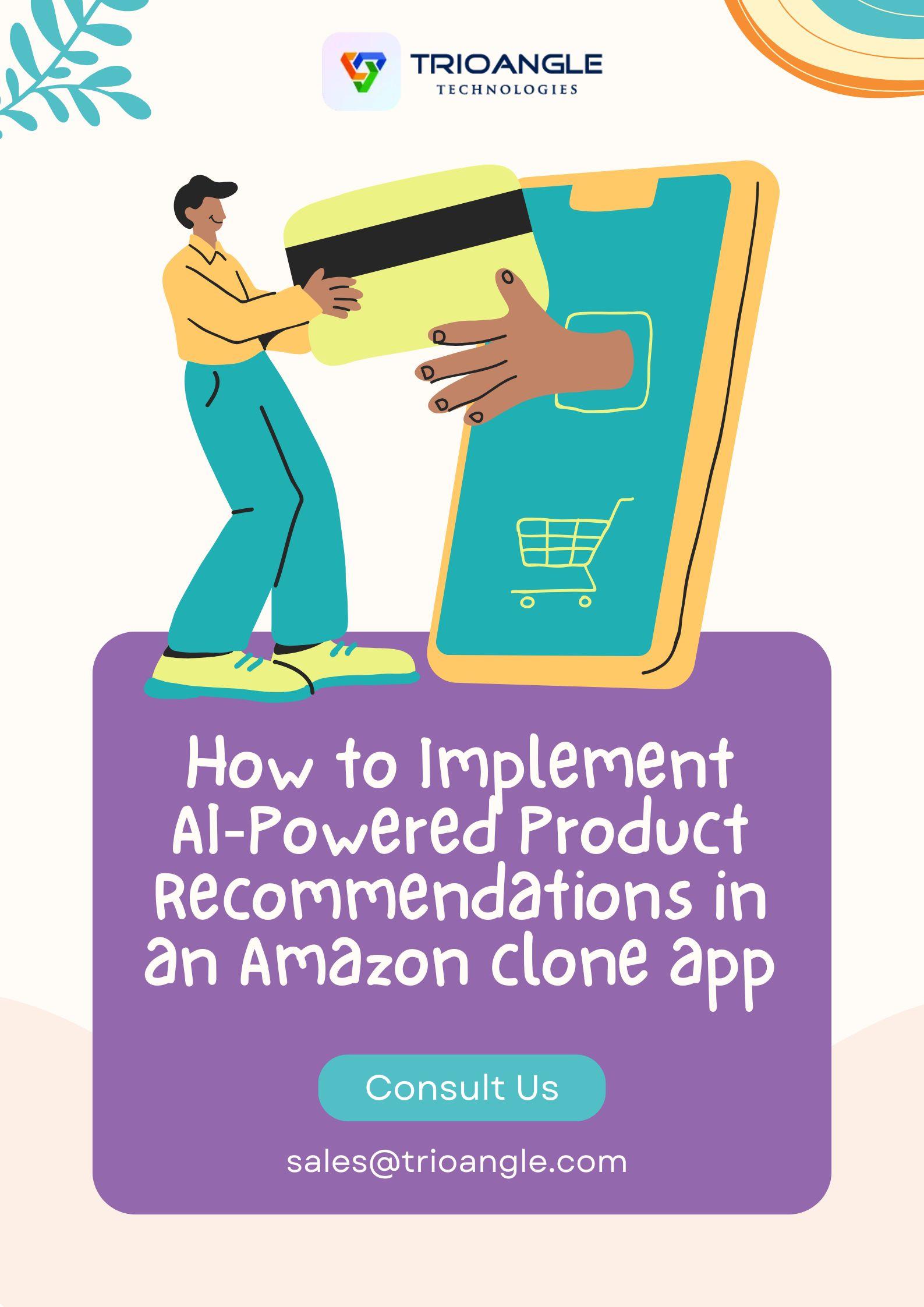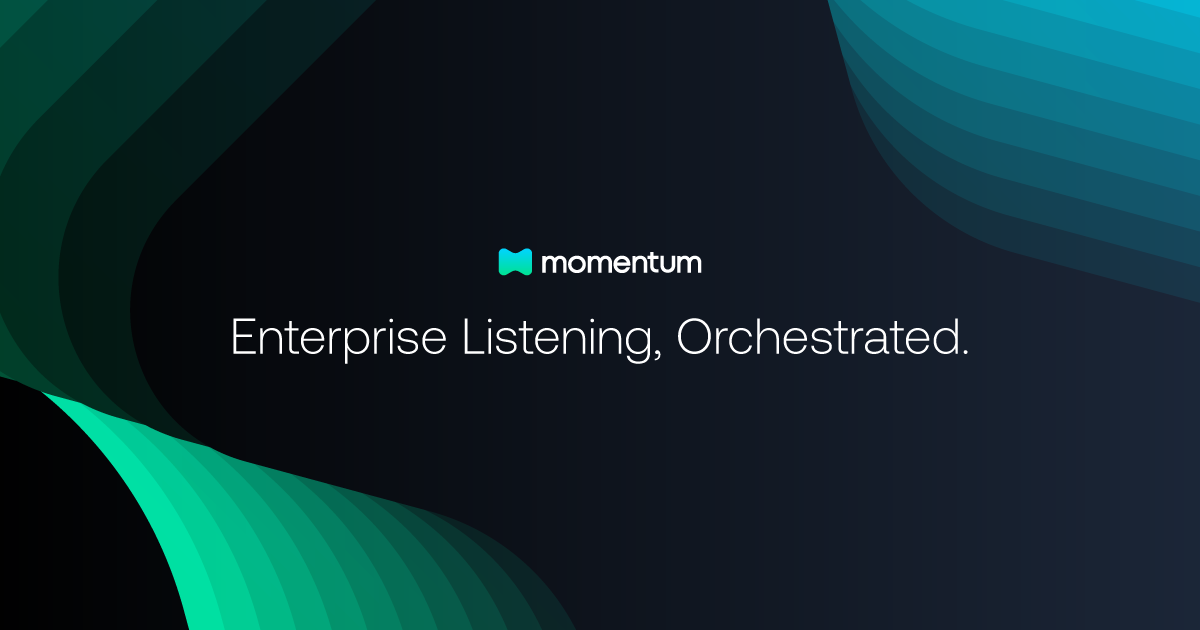How to Implement AI‑Powered Product Recommendations in an Amazon clone app
What if your app could predict what users want, before they even type in a search? That’s the power of AI recommendations. Do you want to know how to implement AI-powered product recommendations in your Amazon clone? Here are some steps. Let's dive in.
What is AI-Powered Recommendation?
An artificially intelligent system that makes real-time product recommendations to consumers based on their interests, behaviour, and previous purchases is known as an AI-powered recommendation system in e-commerce. AI customises the shopping experience to boost sales, engagement, and customer satisfaction rather than displaying the same product list to every user.
Types of recommendation strategies:
1. Collaborative Filtering
Collaborative Filtering is a recommendation strategy that recommends products based on user activity and preferences rather than product information in an Amazon-like app.
User-based collaborative filtering detects folks who share similar interests. If a user likes a product, it will be recommended to another person who shares their interests.
Item-based collaborative filtering: This type of filtering shows recommendations based on similarities. For example, it recommends a phone case to the people who purchased New phones.
2. Content-based Filtering:
Content-based filtering recommends products based on the traits or features that the customer has previously purchased. For example, if you frequently buy or see bags, the algorithm would suggest alternatives or products with comparable characteristics such as brand, style, price range, or material.
3. Hybrid Filtering:
Hybrid filtering blends collaborative filtering, which proposes products based on the preferences of other users, with content-based filtering, which recommends items similar to those a user has previously liked. This strategy takes advantage of both methods' strengths while correcting their faults, yielding more accurate and personalised recommendations.
4. Trending and popular items:
In an Amazon clone website, Trending or Popular Items recommendations highlight things that are currently best-sellers, most viewed, or highly rated throughout the platform or within a category. Helping consumers find popular, in-demand items while increasing interaction and revenue.
5. Personalized rankings:
Personalized rankings reorder the search results or other lists of items based on users' preferences and behaviour. Instead of showing the same products to every user, it improves the user experience and increases the platform engagement.
Implementing AI-powered recommendations in an Amazon clone app:
Implement AI-powered suggestions in your Amazon clone. You should concentrate on collecting data, selecting the best AI solution, and optimising recommendations.
1. Data Collection and analysis:
Collect vast data: Gather the users' purchase history, product preferences, browsing habits, and product interactions such as clicks, add to cart, and reviews. Collecting these diverse data points provides a detailed picture of each customer's interests and habits.
2. Choosing the Right AI Solution:
Utilise data points: Analyse individual consumer preferences, detect bigger trends across users, and create dynamic customer profiles that evolve as new data is received.
Ensure data privacy: When developing AI-powered product suggestions, you must protect the privacy and security of user data. Encryption, secure servers, and access controls can all help to protect user data from unauthorised access. This is especially important when dealing with sensitive information such as purchasing history, behaviour, or personal details.
Consider Your Needs: Before deciding on an AI recommendation, you should first understand your business goals, budget, and technical resources.
Investigate diverse AI models: There are several recommendation models, each with a unique function. There are three types of filtering: collaborative, content-based, and hybrid.
Look for user-friendly options: If you're not ready to start from scratch with an Amazon clone website, look for choices that are easy to use. Many e-commerce platforms have built-in AI recommendation algorithms or third-party applications.
3. Implementing and optimizing recommendations:
Integrate cross-platform: Ensure that your recommendations are consistent and personalised across all platforms, including the website, email marketing, mobile app, and even customer support chat. This will improve the user experience and maintain personalisation seamlessly.
Use various formats: Use several recommendation styles, such as pop-ups and inline sections, to keep shoppers' attention at different phases of their purchasing journey.
A/B testing and optimisation: Continuously monitor the performance of the recommendations and make improvements depending on data and user input.
Focus on user experience: Make sure that recommendations are not only appropriate but also easy to navigate, quick to load, and visually integrated on mobile sites.
Prioritise Explainability: Be open about how recommendations are made, and give users control over their preferences.
Begin small, then scale: Start with a pilot or test group to validate performance and get feedback. Use this feedback to develop and expand your recommendation system throughout the platform.
Benefits of AI-powered recommendations:
1. Improved conversion performance:
The AI algorithm examines clients' browsing histories and purchasing habits to help them get what they want without using their hands. This will boost your Amazon clone conversion rate.
2. Enhanced user experience:
This AI-powered customised suggestion saves users time and effort by guiding them to the proper products. The end outcome is customer satisfaction and a good purchasing experience.
3. Increased average order value:
AI-powered suggestions in your Amazon clone app encourage customers to buy complementary, upsell, and cross-sell items, which raises the overall order value.
4. Insights based on data:
Artificial intelligence (AI) recommendation systems gather and analyse consumer data to learn about preferences and purchasing habits. Businesses can use this to enhance their marketing, select better products to sell, and more effectively manage their inventory.
5. Improved customer retention:
When users consistently receive relevant product recommendations, they are more likely to return to the platform. This strengthens brand presence and generates recurring sales.
6. Enhanced marketing strategies:
AI-powered recommendations customize marketing strategies based on each customer’s individual preferences and behaviors. This personalized approach results in more relevant and engaging marketing campaigns that resonate better with customers, ultimately increasing their interest and likelihood to respond positively.
7. Reduced cart abandonment:
AI-powered recommendations lower cart abandonment by using personalized recommendations, timely reminders, and providing discounts or free shipping. These strategies help users complete their purchases and increase the overall sales rates in your Amazon clone website.
8. Real-time discovery:
This enables AI to make real-time product recommendations to users based on their interests, assisting consumers in finding things they may not have previously found. It is most helpful in vast product catalogues where customers may find manual searching daunting. AI speeds up, simplifies, and enhances the pleasure of shopping by providing timely and pertinent recommendations.
Summing up:
I hope this blog helps you understand the importance of Artificial Intelligence in product recommendations for your Amazon clone app.
It covers the implementation of AI-powered recommendation systems, different types of recommendation strategies, and their benefits.
Now is the perfect time to launch AI-powered recommendations in your Amazon clone app.
https://www.trioangle.com/amazon-clone/
#EcommercePlatform #TechForBusiness #AmazonCloneScript #USAeCommerce #EcommerceLondon #MiddleEastEcommerce #SAOnlineStore# OnlineMarketplace
#MultiVendorMarketplace #DigitalRetailUSA #UAEStartupScene #MarketplaceTrends
What if your app could predict what users want, before they even type in a search? That’s the power of AI recommendations. Do you want to know how to implement AI-powered product recommendations in your Amazon clone? Here are some steps. Let's dive in.
What is AI-Powered Recommendation?
An artificially intelligent system that makes real-time product recommendations to consumers based on their interests, behaviour, and previous purchases is known as an AI-powered recommendation system in e-commerce. AI customises the shopping experience to boost sales, engagement, and customer satisfaction rather than displaying the same product list to every user.
Types of recommendation strategies:
1. Collaborative Filtering
Collaborative Filtering is a recommendation strategy that recommends products based on user activity and preferences rather than product information in an Amazon-like app.
User-based collaborative filtering detects folks who share similar interests. If a user likes a product, it will be recommended to another person who shares their interests.
Item-based collaborative filtering: This type of filtering shows recommendations based on similarities. For example, it recommends a phone case to the people who purchased New phones.
2. Content-based Filtering:
Content-based filtering recommends products based on the traits or features that the customer has previously purchased. For example, if you frequently buy or see bags, the algorithm would suggest alternatives or products with comparable characteristics such as brand, style, price range, or material.
3. Hybrid Filtering:
Hybrid filtering blends collaborative filtering, which proposes products based on the preferences of other users, with content-based filtering, which recommends items similar to those a user has previously liked. This strategy takes advantage of both methods' strengths while correcting their faults, yielding more accurate and personalised recommendations.
4. Trending and popular items:
In an Amazon clone website, Trending or Popular Items recommendations highlight things that are currently best-sellers, most viewed, or highly rated throughout the platform or within a category. Helping consumers find popular, in-demand items while increasing interaction and revenue.
5. Personalized rankings:
Personalized rankings reorder the search results or other lists of items based on users' preferences and behaviour. Instead of showing the same products to every user, it improves the user experience and increases the platform engagement.
Implementing AI-powered recommendations in an Amazon clone app:
Implement AI-powered suggestions in your Amazon clone. You should concentrate on collecting data, selecting the best AI solution, and optimising recommendations.
1. Data Collection and analysis:
Collect vast data: Gather the users' purchase history, product preferences, browsing habits, and product interactions such as clicks, add to cart, and reviews. Collecting these diverse data points provides a detailed picture of each customer's interests and habits.
2. Choosing the Right AI Solution:
Utilise data points: Analyse individual consumer preferences, detect bigger trends across users, and create dynamic customer profiles that evolve as new data is received.
Ensure data privacy: When developing AI-powered product suggestions, you must protect the privacy and security of user data. Encryption, secure servers, and access controls can all help to protect user data from unauthorised access. This is especially important when dealing with sensitive information such as purchasing history, behaviour, or personal details.
Consider Your Needs: Before deciding on an AI recommendation, you should first understand your business goals, budget, and technical resources.
Investigate diverse AI models: There are several recommendation models, each with a unique function. There are three types of filtering: collaborative, content-based, and hybrid.
Look for user-friendly options: If you're not ready to start from scratch with an Amazon clone website, look for choices that are easy to use. Many e-commerce platforms have built-in AI recommendation algorithms or third-party applications.
3. Implementing and optimizing recommendations:
Integrate cross-platform: Ensure that your recommendations are consistent and personalised across all platforms, including the website, email marketing, mobile app, and even customer support chat. This will improve the user experience and maintain personalisation seamlessly.
Use various formats: Use several recommendation styles, such as pop-ups and inline sections, to keep shoppers' attention at different phases of their purchasing journey.
A/B testing and optimisation: Continuously monitor the performance of the recommendations and make improvements depending on data and user input.
Focus on user experience: Make sure that recommendations are not only appropriate but also easy to navigate, quick to load, and visually integrated on mobile sites.
Prioritise Explainability: Be open about how recommendations are made, and give users control over their preferences.
Begin small, then scale: Start with a pilot or test group to validate performance and get feedback. Use this feedback to develop and expand your recommendation system throughout the platform.
Benefits of AI-powered recommendations:
1. Improved conversion performance:
The AI algorithm examines clients' browsing histories and purchasing habits to help them get what they want without using their hands. This will boost your Amazon clone conversion rate.
2. Enhanced user experience:
This AI-powered customised suggestion saves users time and effort by guiding them to the proper products. The end outcome is customer satisfaction and a good purchasing experience.
3. Increased average order value:
AI-powered suggestions in your Amazon clone app encourage customers to buy complementary, upsell, and cross-sell items, which raises the overall order value.
4. Insights based on data:
Artificial intelligence (AI) recommendation systems gather and analyse consumer data to learn about preferences and purchasing habits. Businesses can use this to enhance their marketing, select better products to sell, and more effectively manage their inventory.
5. Improved customer retention:
When users consistently receive relevant product recommendations, they are more likely to return to the platform. This strengthens brand presence and generates recurring sales.
6. Enhanced marketing strategies:
AI-powered recommendations customize marketing strategies based on each customer’s individual preferences and behaviors. This personalized approach results in more relevant and engaging marketing campaigns that resonate better with customers, ultimately increasing their interest and likelihood to respond positively.
7. Reduced cart abandonment:
AI-powered recommendations lower cart abandonment by using personalized recommendations, timely reminders, and providing discounts or free shipping. These strategies help users complete their purchases and increase the overall sales rates in your Amazon clone website.
8. Real-time discovery:
This enables AI to make real-time product recommendations to users based on their interests, assisting consumers in finding things they may not have previously found. It is most helpful in vast product catalogues where customers may find manual searching daunting. AI speeds up, simplifies, and enhances the pleasure of shopping by providing timely and pertinent recommendations.
Summing up:
I hope this blog helps you understand the importance of Artificial Intelligence in product recommendations for your Amazon clone app.
It covers the implementation of AI-powered recommendation systems, different types of recommendation strategies, and their benefits.
Now is the perfect time to launch AI-powered recommendations in your Amazon clone app.
https://www.trioangle.com/amazon-clone/
#EcommercePlatform #TechForBusiness #AmazonCloneScript #USAeCommerce #EcommerceLondon #MiddleEastEcommerce #SAOnlineStore# OnlineMarketplace
#MultiVendorMarketplace #DigitalRetailUSA #UAEStartupScene #MarketplaceTrends
How to Implement AI‑Powered Product Recommendations in an Amazon clone app
What if your app could predict what users want, before they even type in a search? That’s the power of AI recommendations. Do you want to know how to implement AI-powered product recommendations in your Amazon clone? Here are some steps. Let's dive in.
What is AI-Powered Recommendation?
An artificially intelligent system that makes real-time product recommendations to consumers based on their interests, behaviour, and previous purchases is known as an AI-powered recommendation system in e-commerce. AI customises the shopping experience to boost sales, engagement, and customer satisfaction rather than displaying the same product list to every user.
Types of recommendation strategies:
1. Collaborative Filtering
Collaborative Filtering is a recommendation strategy that recommends products based on user activity and preferences rather than product information in an Amazon-like app.
User-based collaborative filtering detects folks who share similar interests. If a user likes a product, it will be recommended to another person who shares their interests.
Item-based collaborative filtering: This type of filtering shows recommendations based on similarities. For example, it recommends a phone case to the people who purchased New phones.
2. Content-based Filtering:
Content-based filtering recommends products based on the traits or features that the customer has previously purchased. For example, if you frequently buy or see bags, the algorithm would suggest alternatives or products with comparable characteristics such as brand, style, price range, or material.
3. Hybrid Filtering:
Hybrid filtering blends collaborative filtering, which proposes products based on the preferences of other users, with content-based filtering, which recommends items similar to those a user has previously liked. This strategy takes advantage of both methods' strengths while correcting their faults, yielding more accurate and personalised recommendations.
4. Trending and popular items:
In an Amazon clone website, Trending or Popular Items recommendations highlight things that are currently best-sellers, most viewed, or highly rated throughout the platform or within a category. Helping consumers find popular, in-demand items while increasing interaction and revenue.
5. Personalized rankings:
Personalized rankings reorder the search results or other lists of items based on users' preferences and behaviour. Instead of showing the same products to every user, it improves the user experience and increases the platform engagement.
Implementing AI-powered recommendations in an Amazon clone app:
Implement AI-powered suggestions in your Amazon clone. You should concentrate on collecting data, selecting the best AI solution, and optimising recommendations.
1. Data Collection and analysis:
Collect vast data: Gather the users' purchase history, product preferences, browsing habits, and product interactions such as clicks, add to cart, and reviews. Collecting these diverse data points provides a detailed picture of each customer's interests and habits.
2. Choosing the Right AI Solution:
Utilise data points: Analyse individual consumer preferences, detect bigger trends across users, and create dynamic customer profiles that evolve as new data is received.
Ensure data privacy: When developing AI-powered product suggestions, you must protect the privacy and security of user data. Encryption, secure servers, and access controls can all help to protect user data from unauthorised access. This is especially important when dealing with sensitive information such as purchasing history, behaviour, or personal details.
Consider Your Needs: Before deciding on an AI recommendation, you should first understand your business goals, budget, and technical resources.
Investigate diverse AI models: There are several recommendation models, each with a unique function. There are three types of filtering: collaborative, content-based, and hybrid.
Look for user-friendly options: If you're not ready to start from scratch with an Amazon clone website, look for choices that are easy to use. Many e-commerce platforms have built-in AI recommendation algorithms or third-party applications.
3. Implementing and optimizing recommendations:
Integrate cross-platform: Ensure that your recommendations are consistent and personalised across all platforms, including the website, email marketing, mobile app, and even customer support chat. This will improve the user experience and maintain personalisation seamlessly.
Use various formats: Use several recommendation styles, such as pop-ups and inline sections, to keep shoppers' attention at different phases of their purchasing journey.
A/B testing and optimisation: Continuously monitor the performance of the recommendations and make improvements depending on data and user input.
Focus on user experience: Make sure that recommendations are not only appropriate but also easy to navigate, quick to load, and visually integrated on mobile sites.
Prioritise Explainability: Be open about how recommendations are made, and give users control over their preferences.
Begin small, then scale: Start with a pilot or test group to validate performance and get feedback. Use this feedback to develop and expand your recommendation system throughout the platform.
Benefits of AI-powered recommendations:
1. Improved conversion performance:
The AI algorithm examines clients' browsing histories and purchasing habits to help them get what they want without using their hands. This will boost your Amazon clone conversion rate.
2. Enhanced user experience:
This AI-powered customised suggestion saves users time and effort by guiding them to the proper products. The end outcome is customer satisfaction and a good purchasing experience.
3. Increased average order value:
AI-powered suggestions in your Amazon clone app encourage customers to buy complementary, upsell, and cross-sell items, which raises the overall order value.
4. Insights based on data:
Artificial intelligence (AI) recommendation systems gather and analyse consumer data to learn about preferences and purchasing habits. Businesses can use this to enhance their marketing, select better products to sell, and more effectively manage their inventory.
5. Improved customer retention:
When users consistently receive relevant product recommendations, they are more likely to return to the platform. This strengthens brand presence and generates recurring sales.
6. Enhanced marketing strategies:
AI-powered recommendations customize marketing strategies based on each customer’s individual preferences and behaviors. This personalized approach results in more relevant and engaging marketing campaigns that resonate better with customers, ultimately increasing their interest and likelihood to respond positively.
7. Reduced cart abandonment:
AI-powered recommendations lower cart abandonment by using personalized recommendations, timely reminders, and providing discounts or free shipping. These strategies help users complete their purchases and increase the overall sales rates in your Amazon clone website.
8. Real-time discovery:
This enables AI to make real-time product recommendations to users based on their interests, assisting consumers in finding things they may not have previously found. It is most helpful in vast product catalogues where customers may find manual searching daunting. AI speeds up, simplifies, and enhances the pleasure of shopping by providing timely and pertinent recommendations.
Summing up:
I hope this blog helps you understand the importance of Artificial Intelligence in product recommendations for your Amazon clone app.
It covers the implementation of AI-powered recommendation systems, different types of recommendation strategies, and their benefits.
Now is the perfect time to launch AI-powered recommendations in your Amazon clone app.
https://www.trioangle.com/amazon-clone/
#EcommercePlatform #TechForBusiness #AmazonCloneScript #USAeCommerce #EcommerceLondon #MiddleEastEcommerce #SAOnlineStore# OnlineMarketplace
#MultiVendorMarketplace #DigitalRetailUSA #UAEStartupScene #MarketplaceTrends
0 Comentários
0 Compartilhamentos
0 Anterior










